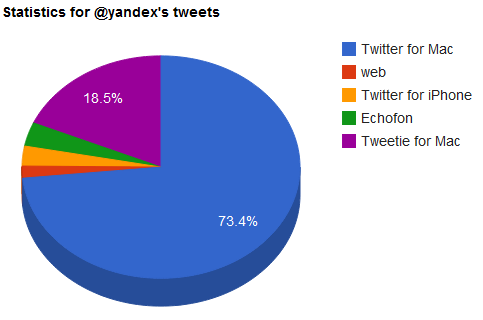Nerd-o-meter - how to tweet
On a gray and rainy St. Petersburg evening, a couple of our programmers, wanting to enhance their knowledge in JS, HTML and CSS, wrote an interesting project for fans of statistics.

Nerd-o-meter is a service that allows you to find out the statistics of devices from which they tweet. You can search both by request and by specific users.
The idea of the project arose during a visit to Yandex.Subbotnik: observing how many people tweeted during the event, it occurred to me that it would be interesting to know the statistics of the devices from which they write and see how it varies from conference to conferences.
A little later, it was transformed into the idea of a small service showing statistics on twitter clients: this information is simply extracted from the Twitter API.
At first it seemed like a classic application, for example, on Rails, but at some point it became clear that the server part is simply superfluous: all that is needed, in particular access to the Twitter API and graphing, is available directly in the browser. Thus, we got a small and lightweight single-page app.
To build the charts, Google Chart Tools was used , glancing briefly towards several alternative solutions.
An excellent collection of microjs.com helped me in finding the libraries necessary for the development (although in such a small project you could probably do without them) .
In addition to Chart Tools, the following libraries came in handy:
As a result, we got a working tool for collecting statistics, for which I want to thank digal , damnerd and Philip Nurulin. Now we know, for example, that the person responsible for Yandex twitter is not indifferent to Apple products :-)

PS Thanks to the comments, Nerd-o-meter has added sorting of results by popularity.

Nerd-o-meter is a service that allows you to find out the statistics of devices from which they tweet. You can search both by request and by specific users.
Idea
The idea of the project arose during a visit to Yandex.Subbotnik: observing how many people tweeted during the event, it occurred to me that it would be interesting to know the statistics of the devices from which they write and see how it varies from conference to conferences.
A little later, it was transformed into the idea of a small service showing statistics on twitter clients: this information is simply extracted from the Twitter API.
Creature
At first it seemed like a classic application, for example, on Rails, but at some point it became clear that the server part is simply superfluous: all that is needed, in particular access to the Twitter API and graphing, is available directly in the browser. Thus, we got a small and lightweight single-page app.
To build the charts, Google Chart Tools was used , glancing briefly towards several alternative solutions.
An excellent collection of microjs.com helped me in finding the libraries necessary for the development (although in such a small project you could probably do without them) .
In addition to Chart Tools, the following libraries came in handy:
- Zepto.js : A lightweight jquery replacement aimed primarily at mobile webkit browsers. Nevertheless, it is quite decent and works as an "adult library". In the course of work, a small bug was found when working with FF, but was quickly fixed by a patch, which was later sent (and accepted) back to the zepto project on GitHub. Used to manipulate the DOM and ajax requests to the API.
- Underscore.js : at work, one of the programmers used Scala, so without comfortable functional ways to work with collections (at least map / filter), he felt like without hands. Underscore provided such an opportunity and some other FP-buns.
- SugarSkull : The first version of the application used a self-written mechanism for permanent links that could work entirely on the client side. With the introduction of another type of statistics (on the tweets of a specific user), the url scheme became more complicated and this library was bolted. It is a simple client-side url dispatch mechanism.
As a result, we got a working tool for collecting statistics, for which I want to thank digal , damnerd and Philip Nurulin. Now we know, for example, that the person responsible for Yandex twitter is not indifferent to Apple products :-)

PS Thanks to the comments, Nerd-o-meter has added sorting of results by popularity.
